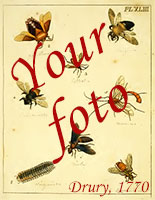Pepsis fuscipennis Fabricius, 1804:210, sex not indicated.America meridionali (Mus. D. Lund, leg. Smidt). - Dalla Torre, 1897Dalla Torre, C.G. 1897. Catalogus hymenopterorum hucusque descriptorum systematicus et synonymicus. Volumen VIII: Fossores (Sphegidae). Breitkopf & Härtel, Leipzig. 1-749.:254 (listed); Vardy, 2005Vardy, C.R. 2005. The New World tarantula-hawk wasp genus Pepsis Fabricius (Hymenoptera: Pompilidae). Part 3. The P. inclyta- to P. auriguttata-groups. Zoologische Mededelingen Leiden 79 (5):1-305.:288 (listed, listed as synonym of Entypus gigas (Fabricius, 1804)). - As Isodontia fuscipennis: - Callan, 1990Callan, E.Mc C. 1990. Sphecidae of Trinidad. I. Ampulicinae, Sphecinae and Pemphredoninae. Sphecos 20:19. (distribution); Amarante, 2002Amarante, S.T.P. 2002. A synonymic catalog of the neotropical Crabronidae and Sphecidae (Hymenoptera: Apoidea). Arquivos de Zoologia (São Paulo) 37:1-139. (distribution); Starr & Hook, 2003Starr, C.K. & Hook, A.W. 2003. The aculeate Hymenoptera of Trinidad, West Indies. Occasional Papers o the Department of Life Sciences, University of the West Indies 12:1-31. (distribution); Vardy, 2005Vardy, C.R. 2005. The New World tarantula-hawk wasp genus Pepsis Fabricius (Hymenoptera: Pompilidae). Part 3. The P. inclyta- to P. auriguttata-groups. Zoologische Mededelingen Leiden 79 (5):1-305.:288 (listed); Horta Vega et al., 2007Horta Vega, J.V., O.N. Pinson Domínguez, L. Barrientos Lozano & A. Correa Sandoval 2007. Sphecidae y Crabronidae (Hymenoptera) de algunos municipios del centro y sur de Tamaulipas, México. Acta Zool. Mex. (n.s.) 23:35-48. (distribution).
Sphex chrysobapta Smith, 1856:257, ♀. ♀, Brazil (F. Smith). - Amarante, 2002Amarante, S.T.P. 2002. A synonymic catalog of the neotropical Crabronidae and Sphecidae (Hymenoptera: Apoidea). Arquivos de Zoologia (São Paulo) 37:1-139.:73 ( listed as synonym of Isodontia fuscipennis (Fabricius, 1804)).
Sphex petiolata Smith, 1856:259, ♂. ♂, Brazil (Para) (H. W. Bates). - Cameron, 1888-1900Cameron, P. 1888-1900. Biologia Centrali-Americana - Insecta. Hymenoptera. (Fossores) Vol. II. R. H. Porter and Dulau & Co., London. 413pp, 14 pl.:35 ( listed as synonym of Sphex costipennis Spinola, 1851); Amarante, 2002Amarante, S.T.P. 2002. A synonymic catalog of the neotropical Crabronidae and Sphecidae (Hymenoptera: Apoidea). Arquivos de Zoologia (São Paulo) 37:1-139.:73 ( listed as synonym of Isodontia fuscipennis (Fabricius, 1804)).

